Regular readers of my blog may know that I use a Panasonic G1 digital camera.
So why would I do this comparison?
We happen to have a Pentax *ist camera in the office, which I've used a few times and generally thought it was a "vanilla" sort of DSLR. I had always thought it was more or less the equal of my older Canon 10D. However after recently taking a picture of the plover chick with it ...

I stunned how badly it took photographs.
The only day that I didn't have my G1 at work (all the other plover shots are taken with it) and I get to see the chick just after it has hatched and I had this miserable image. My initial view of the image left me shocked how bad it was (I took a few and they all sucked), after all this camera should be more or less similar spec to my 10D (which was quite acceptable).
I looked around the image and realized that it had back focused.
I was reminded of the problems I regularly faced with my Canon 10D and 20D and having used the G1 for so long had more or less forgotten about this issue. The AF on the G1 (particularly with the kit zoom but any other AF lens) is fantastic and has been spot on each and every time.
Then after a recent conversation with a workmate about him not wanting a G1 but "proper SLR" camera (and he mentioned the Pentax) I thought that it might be interesting to see what was what with these two cameras.
I'm not mad about megapixels, and other image qualites (such as noise) can make a better image, so I thought that it might be valuable to see if the Pentax could do a better job of a shot than the G1.
With that in mind I thought I'd do a few quick test shots in the office with the aim in mind of just examining the images for noise. I intended to test at:
- 200 ISO
- 400 ISO
- 800 ISO
- 1600 ISO
- 3200 ISO
The office Pentax has a Sigma 18-55mm zoom on it while my Panasonic had the 14-45 standard kit zoom on it. I took my shots and when I got home and loaded them on the computer I was quite stunned.
I thought (using generalizations like x1.6 and x2) that the lenses would be quite close to each other at the long end (88mm vs 90mm), but that was the first surprise
The overviews:
Pentax ist
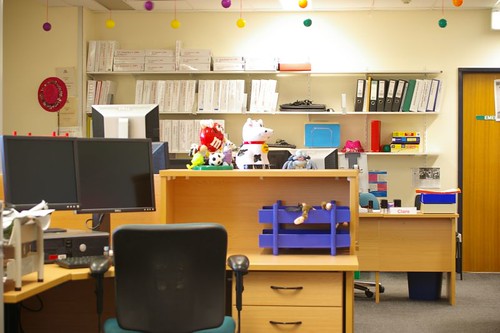
Panasonic G1

As you can see above the horizontal capture is really quite wider on the Pentax (with its APS-C 23.5 x 15.7mm sized sensor) than the G1 (slightly smaller 18 x 13.5mm sensor), making this format a much better choice for Landscape style shooting ... this is a slightly unexpected outcome from my perspective. While I had the 10D right up until I bought the G1 I didn't make exactly this sort of comparison.
The next thing which stood out to me was the fact that the Pentax images seemed quite soft and blurry t me. Closer examination shows some interesting things ...
My focal point was the toys on the desk, and they were so much sharper on the G1 image than on the Pentax image. To make this comparison easier, I resized the image from the G1 back to being 2000 pixels high: the same as the Pentax.
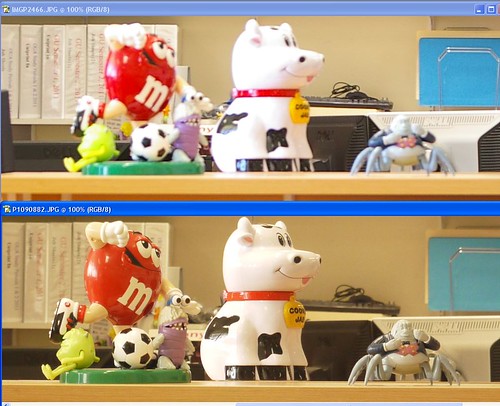
The G1 focus is perfect on the toys (look at the face of the crab man on the right). The answer is I believe that the Pentax was back focusing. Looking at the Dell monitor in the mid background and the mouse and keyboard shows that indeed the focus of the Pentax is back focused.
Just to iterate this point, here is one that the G1 image not scaled down:

I repeated these shots a number of times, not only for each of the above ISO steps but I also tried again deliberately after seeing these results and every time I got exactly this result.
In fact I went outside the next day (after finding these results) and took these shots of this flower to see if the focus was still back focused.
Pentax:
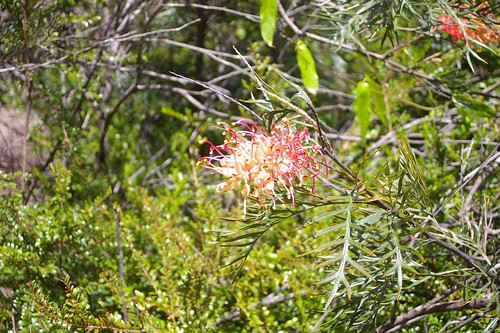
G1:
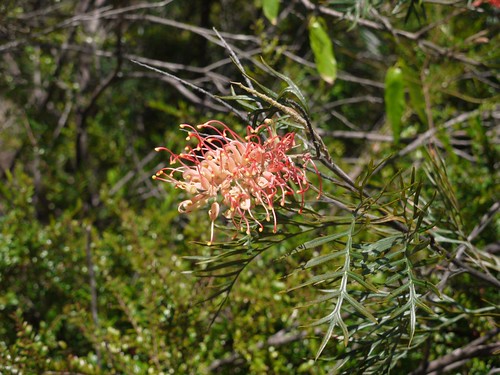
Look carefully at the Pentax image, the focus seems to be at the back of the flower at the stem. The G1 focused just where the focus point was.
I left both cameras on Av at f5.6 and found not only that the G1 focused better on this clear easy central target, but that the G1 picked exposure better too!
wow ...
This is quite significant, forgetting all other factors (lens, sensor noise, number of pixels ...) if the camera can't focus for you properly then no matter what : it will be a poor image.
Ok ... lets get back to the noise:
I picked the chair back and the red channel (as it and blue are the noisiest ones) to examine.
200:
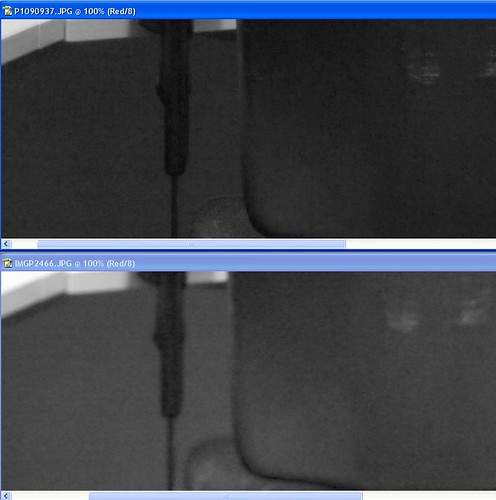
However when I started to examine the other higher ISO images I found that it starts to get a bit less clear. I'll show you what I mean.

The Pentax image (the top one) seems to be blurrier than the G1 image, with the details in the back focused crab man clearly favoring the G1, but notice how the writing of DELL in the black monitor really drops in detail compared to the Pentax?
I don't know exactly where critical focus was on the Pentax (if it was anywhere) but even at 400ISO it seems that the Pentax is holding together better than the G1 is.
Any difference in noise is hardly visible but to me the side effect of noise control - the destruction of detail is becoming evident. This for instance is the comparison between the Pentax JPG and the G1 RAW file (converted in PhotoShop)
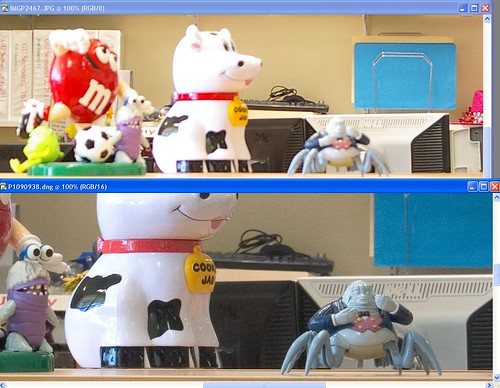
The Dell in the black is little less washy but the noise is ramping up, yet we are only at 400 ISO. Lets step this up by moving to 1600ISO.
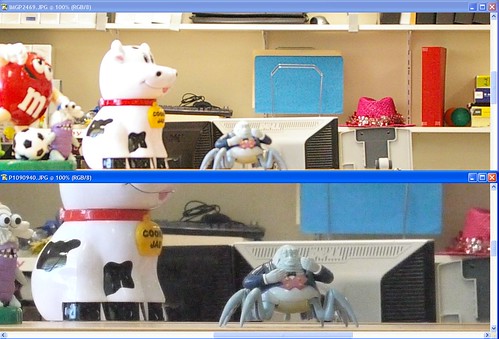
Here I see that the loss of detail in the G1 image is marked, the Pentax is showing some chrominance noise in the black areas but holding details better. Something I started to notice however was the saturation of channels in the Pentax is higher than in the G1. This would be an interesting thing to test for: does the Pentax control signal to noise with sacrificing of dynamic range? When we look at the G1 Raw vs Pentax we can see though that the Panasonic is doing some amazing processing to dress down noise:
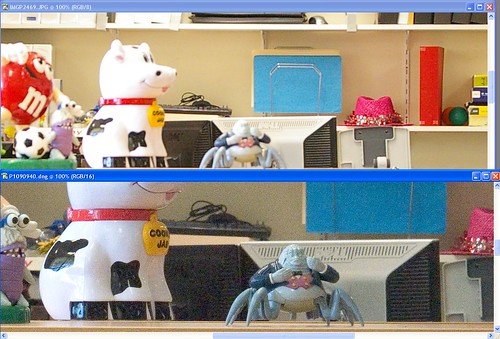
This makes me wish I'd taken shots with the Pentax in RAW to make comparisons between them too. Perhaps another time.
So moving along to 3200 we see this:
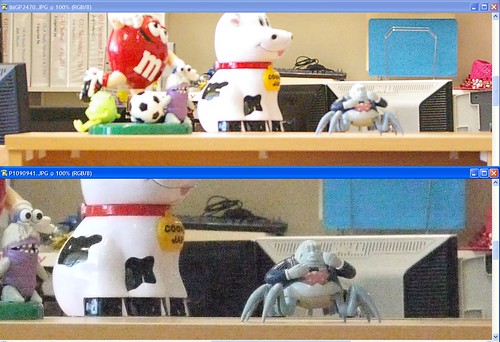
Noise is quite horrid on the G1 however other image aspects (like exposure and dynamics) seem to hold up better. If I scale the G1 image down to be 2000 pixels high, what effect will that have on this noise?
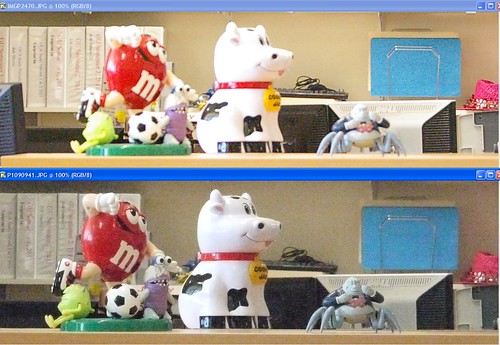
Well it starts to look less "in your face" than it did before (which is good) ; which suggests to me that if you were doing 8x10 prints from each that the G1 image would look better than the Pentax image in areas like:
- Focus
- Exoposure
- Noise
conclusions?
While I'm not as clear as I hoped I would be about the older larger sensor having any noise advantage (by having "bigger pixels") I have confirmed a few things about the G1 which do help me make sure I get better images.In particular focus, and the ability to be sure of what I focus on. In the hit and miss world of "grab it" shots maybe either would be equal, but when I have a moment to take a photograph (say some scenery, or a family gathering portrait) I know that the G1 will give me a better image.
I have not discussed it yet, but when I started taking the pictures with the Pentax I used manual focus on my first set of pictures (not used here), these were clear in the view finder (piddly little thing that it is) yet the images were as we see here ... poor.
I then re-shot the images and used AF paying attention to the focus points and double and triple half pressing to allow the camera to settle AF and be as certain as possible of AF. There was no discernible difference between the AF and the Manually focused images, yet in all cases the image looked "clear" in the viewfinder.
Perhaps the explanation of this focus issue is poor alignment of the focusing screen (which leads to errors in focus). What ever the cause is the fact that the G1 shows you the image that focuses on the sensor and not something reflected by mirrors onto a focusing screen gives you the advantage of what you see is what you get.
So I'm still happy with my G1











3 comments:
Thast is an amazing result!
There are a lot of focusing problems with dslrs and slrs with screens and mirors out of whack.
I've got a F4 body that refuses to focus properly, while another one is perfect. I've swapped screens between the two and problem is still there, so it must be the mirror.
The F6 has a slight back focus problem since I changed the screen to one with a split rangefinder to help with manual focusing!
The F, F2 and D80 are fine, but the D200 definitely has a front focus problem, which I am hoping to fix soon by dropping a Beaty intenscreen on it...
Even the Mamiya 645 Pro-TL developed a focusing problem after I changed the screen to an Intenscreen one. Now it's OK, but I had to be very firm with the seating!
One day I'll get the patience to learn how to fine tune all these.
Meanwhile in a lot of instances I take a few guesses...
You're absolutely right: high time the image is really wysiwyg. I am so tempted by those NEX-3 and 5 from Sony...
I particularly disagree with the approach taken in this analysis. Your conclusions seem to be mislead by the fact that this particular *ist unit had some problems with back/front focusing issues. It is impossible to have such issues with a mirrorless camera. Comparing JPG files neither is a good idea, considering that the time span between these two cameras were announced (and their processor engines) is 5 years. This is not a minor detail, in fact between 2003 and 2008 technological advances in digital photography, particularly on sensors, were considerable. RAW image comparison would have been more fair in this case.
I also disagree with your observation regarding the *istD viewfinder, which is fair bright and large, delivering a x0.95 magnification and covering 95%. Manual focus depends, however, on the user skills. I am also struck by your opinion on the *istD metering system. This particular light meter is one of the best ones that I have seen in many DSLR. And it is a 2003 camera. The shots I take with this camera are always perfect as long as light metering concerns. Not even in hard contrast situations. Whether you used the central point metering instead of the other options could lead to strange issues as you show in the pictures. Anyhow, if you happen to use one *ist camera again, particularly those with a pentaprism viewfinder, I suggest you to give it another chance, shot with an old pentax bright prime and in raw. It is a lovely old and reliable camera that I still use sometimes, instead of other more recent gear.
best wishes.
PS:
>RAW image comparison would have been more fair in this case
I agree entirely ... its what I would normally do, but in this case I wasn't trying to do a micro fine analysis I just wanted to compare ball park stuff. I didn't comment on colour rendition nor on the quality of or differences in JPG rendering.
Given that the VAST majority of people use JPG not RAW (like the people in my office who uses these cameras for our work) the comparison stands. (and the *ist sits in a cupboard as we're using a G2 since soon after this post and now years later a GH4)
I'll leave it to others to fiddle around with warranty swaps on back / front focus issues (which will kill an image).
Lastly if you think you can critically focus a lens on that optical view finder any better than on a camera with live view and image magnification then that's kudos to you. So far everyone in the office is really happy with the upgrade.
Post a Comment